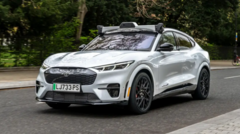Are Driverless Taxis Finally Coming to the UK?

Uber's Robotaxi Trials: The Future of Autonomous Transport in London
As technology continues to evolve at a breakneck pace, the introduction of autonomous vehicles is becoming increasingly imminent. In a significant move that could reshape urban transportation, Uber has announced plans to trial robotaxis—self-driving cars without a human safety driver—in London next spring. This development marks a pivotal moment in the evolution of ride-hailing services and the broader transport landscape. In collaboration with the UK-based AI firm Wayve, Uber is preparing to navigate the complex regulatory environment surrounding autonomous vehicles, all while considering the substantial implications these changes may have on society.
The Landscape of Autonomous Vehicles in the UK
The UK government has recently amended its regulations concerning driverless vehicles, allowing for the accelerated introduction of small autonomous commercial services. Initially, the rollout was expected by 2026, then pushed to late 2027. However, the new framework aims to fast-track these innovations, granting companies like Uber the opportunity to test and potentially deploy driverless technology sooner.
Job Creation vs. Job Displacement
While the Department for Transport estimates that the autonomous vehicle industry could generate up to 38,000 jobs and contribute £42 billion to the UK economy by 2035, there are also concerns regarding the social implications of such a transition. GMB national secretary Andy Prendergast emphasizes the need to consider the significant impact on employment, particularly in roles that involve driving. The shift toward automation in transport raises important questions about job security and the future of work in the sector.
How Will Uber's Robotaxi Service Work?
The details of Uber’s upcoming robotaxi trials are still being finalized. However, the company's intention is clear: as soon as legislation permits, customers will be able to select autonomous vehicles through the Uber app, just like they do with traditional ride-hailing options. This model has already been trialed in Austin, Texas, where Uber launched a robotaxi service earlier this year. In Austin, passengers have the option to ride in a driverless vehicle without any difference in fare.
The Role of Wayve in Autonomous Technology
Wayve’s role in this partnership is critical. The company has been testing its autonomous driving technology on the streets of London under human oversight, which is in accordance with current regulations. The technology involves a sophisticated AI-powered system that allows vehicles to process and respond to real-time traffic conditions, making it a crucial component in ensuring the safety and effectiveness of the trials.
Autonomous Vehicles: Safety Considerations
The safety of autonomous vehicles is a topic of ongoing debate. Studies in the United States suggest that automated vehicles may be less accident-prone than their human-driven counterparts. However, incidents involving robotaxis in other countries, including accidents and technical malfunctions, raise questions about their reliability. For instance, a robotaxi service in San Francisco was canceled following a series of operational failures, highlighting the challenges that lie ahead.
Real-World Testing and Performance
During a recent test ride in a vehicle equipped with Wayve's autonomous technology, the car successfully navigated London's busy streets without human intervention. The AI system adeptly handled various challenges, including congestion, temporary traffic signals, and unexpected obstacles such as pedestrians. The experience was characterized by caution, with the vehicle exhibiting a more measured approach than many human drivers, which contributed to a reassuring journey.
The Future of Urban Transportation
The introduction of robotaxis could fundamentally alter urban transportation. With the ability to operate continuously—Uber's robotaxis in Austin reportedly function for 20 hours a day, seven days a week—these vehicles could provide a more efficient and cost-effective transportation solution. However, this transition also requires addressing the complexities of urban planning, public safety, and regulatory frameworks.
Public Perception and Acceptance
Public perception will play a significant role in the acceptance of autonomous vehicles. Many individuals may have concerns about safety, reliability, and the potential loss of jobs associated with the widespread adoption of driverless technology. Building trust among consumers will be crucial, as will transparent communication regarding the benefits and limitations of autonomous vehicles.
Conclusion
The impending trials of robotaxis in London mark an exciting yet challenging chapter in the evolution of transportation. While the potential benefits, including increased efficiency and economic growth, are enticing, it is essential to consider the broader implications for society. As Uber collaborates with Wayve to bring this technology to fruition, stakeholders must engage in meaningful dialogue about the future of work, public safety, and urban planning.
As we stand on the brink of this technological revolution, one must ponder: How will society adapt to the rise of autonomous vehicles, and what measures can be implemented to ensure a balanced approach that benefits all?
FAQs
What is the timeline for Uber's robotaxi trials in London?
Uber plans to begin trials of its robotaxi service in London next spring, following recent regulatory changes that allow for the accelerated introduction of autonomous vehicles.
What technology is being used in Uber's robotaxi trials?
Uber is collaborating with Wayve, a UK AI firm, which has been testing autonomous driving technology on London's streets. The vehicles will be equipped with AI-powered systems that enable real-time navigation and hazard handling.
What are the potential job implications of autonomous vehicles?
The introduction of autonomous vehicles could create new job opportunities in the tech and transport sectors, but there are concerns about job displacement for drivers and other roles within the industry.
How safe are autonomous vehicles compared to traditional cars?
While studies suggest that automated vehicles may be less prone to accidents than human drivers, incidents involving robotaxis in various countries raise questions about their overall reliability and safety.
How will public acceptance of autonomous vehicles be influenced?
Public acceptance will be influenced by factors such as safety, reliability, transparency in communication, and the perceived impact on employment. Building trust among consumers will be essential for widespread adoption.
As we approach the trial phase of robotaxis, what are your thoughts on the future of transport? Will you embrace this change, or do you have reservations about autonomous vehicles? #Robotaxis #AutonomousVehicles #UrbanTransport
Published: 2025-06-10 08:40:05 | Category: technology



